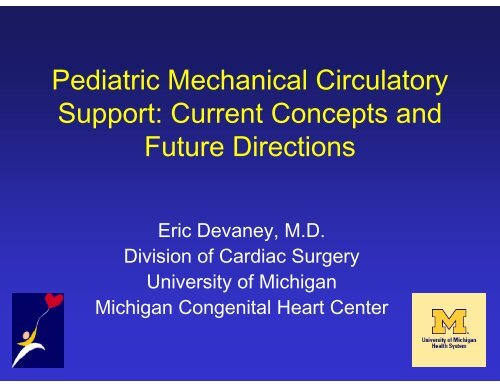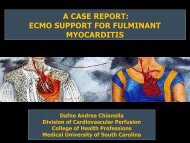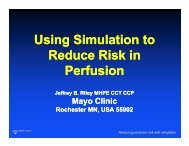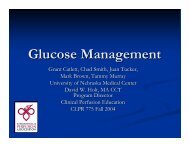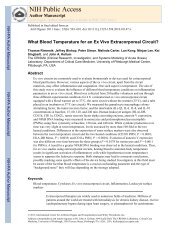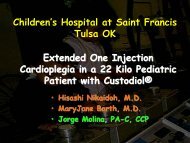Pediatric Mechanical Circulatory Support: Current ... - Perfusion.com
Pediatric Mechanical Circulatory Support: Current ... - Perfusion.com
Pediatric Mechanical Circulatory Support: Current ... - Perfusion.com
You also want an ePaper? Increase the reach of your titles
YUMPU automatically turns print PDFs into web optimized ePapers that Google loves.
<strong>Pediatric</strong> <strong>Mechanical</strong> <strong>Circulatory</strong><br />
<strong>Support</strong>: <strong>Current</strong> Concepts and<br />
Future Directions<br />
Eric Devaney, M.D.<br />
Division of Cardiac Surgery<br />
University of Michigan<br />
Michigan Congenital Heart Center
Disclosures<br />
• No financial relationships<br />
• Berlin Heart IDE Trial Study Center
<strong>Pediatric</strong> <strong>Mechanical</strong> <strong>Circulatory</strong><br />
<strong>Support</strong><br />
• Heart Failure<br />
– Affects 5 million in U.S.<br />
– Lifetime risk 1 in 5<br />
– Un<strong>com</strong>mon in children
<strong>Pediatric</strong> <strong>Mechanical</strong> <strong>Circulatory</strong><br />
<strong>Support</strong><br />
• Treatment<br />
• Pharmacologic<br />
•Surgical<br />
• Transplantation<br />
• <strong>Mechanical</strong> support
<strong>Pediatric</strong> <strong>Mechanical</strong> <strong>Circulatory</strong><br />
<strong>Support</strong><br />
• Heart transplantation<br />
– Small donor pool<br />
– Long waiting list<br />
• “Heart transplantation is epidemiologically<br />
trivial.”<br />
Eric Rose, M.D. 2001
<strong>Pediatric</strong> <strong>Mechanical</strong> <strong>Circulatory</strong><br />
<strong>Support</strong><br />
• Indications<br />
• Goals of therapy<br />
• Overview of available devices<br />
• Results<br />
• Devices in development
Indications for <strong>Pediatric</strong> MCS<br />
• Acute heart failure<br />
– Myocarditis<br />
– Ischemia<br />
– Pulmonary hypertension<br />
– Postcardiotomy failure<br />
• Chronic heart failure<br />
– Cardiomyopathy (dilated, hypertrophic,<br />
restrictive, ischemic)<br />
– Congenital heart disease
Patient Selection for MCS<br />
• Ideal candidate<br />
– Medically refractory heart failure<br />
•Symptoms<br />
• Hemodynamic criteria<br />
–CI < 2.0<br />
–PCW > 20<br />
– Significant hypotension<br />
– Inotrope dependence<br />
d<br />
– Preserved end-organ function
Patient Selection for MCS<br />
• Risk factors<br />
– Oliguria<br />
– Elevated CVP<br />
– PT > 16<br />
– Reoperation<br />
– Fever or leukocytosis<br />
• Operative risk < Risk of heart failure
Goals of Therapy<br />
• Bridge to recovery<br />
• Bridge to transplantation<br />
• Destination therapy
Overview of MCS<br />
• Modalities of support<br />
–ECMO<br />
– Ventricular assist device
Overview of MCS<br />
•ECMO<br />
– Complete cardiopulmonary support<br />
– Continuous flow<br />
– Short-term
Overview of MCS<br />
• Ventricular assist device (VAD)<br />
– Parallel assist of failing ventricle<br />
– Requires functioning lungs<br />
– Longer-term assist
Classification of Devices<br />
• Pump mechanism<br />
– Pulsatile<br />
– Continuous flow<br />
• Power source<br />
– Pneumatic<br />
– Electric<br />
• Pump location<br />
– Intra-, extra-, or paracorporeal<br />
• Duration of support
<strong>Pediatric</strong> <strong>Circulatory</strong> <strong>Support</strong><br />
• Limited options for children<br />
Pulsatile<br />
IABP*<br />
Thoratec*<br />
Abiomed*<br />
HeartMate*<br />
Novacor*<br />
Berlin heart<br />
Medos<br />
Continuous Flow<br />
ECMO*<br />
Biomedicus*<br />
Levitronix<br />
HeartMate II*<br />
Jarvik 2000*<br />
DeBakey Micromed*
Overview of Devices<br />
• Thoratec VAD<br />
– Pulsatile<br />
– Pneumatic<br />
– Para- or intracorporeal<br />
– Long-term
Overview of Devices<br />
• HeartMate VE<br />
– Pulsatile<br />
– Electric<br />
– Intracorporeal<br />
– Long-term
HeartMate II©<br />
Thoratec, Inc., Pleasanton, CA
HeartMate II<br />
• Smaller size<br />
– Smaller patients<br />
– Better QOL<br />
• Smaller driveline<br />
– Reduced infections<br />
– Better QOL<br />
• Quiet operation<br />
– Better QOL<br />
• Single bearing<br />
– Improved durability<br />
• Estimated bearing life 8-10 years<br />
Recently FDA Approved for BTT!
Overview of Devices<br />
• MicroMed DeBakey<br />
VAD<br />
– Continuous flow<br />
– Electric<br />
– Intracorporeal<br />
– Long-term
Overview of Devices<br />
• Jarvik 2000 VAD<br />
– Continuous flow<br />
– Electric<br />
– Intracorporeal<br />
– Intraventricular pump<br />
– Long-term
Overview of Devices<br />
• Tandem Heart<br />
– Percutaneous<br />
– Continuous flow<br />
– Electric<br />
– Extracorporeal<br />
– Short-term
Overview of Devices<br />
• Biomedicus VAD<br />
– Continuous flow<br />
– Electric<br />
– Extracorporeal<br />
– Short-term
HeartMate II
HVAD©<br />
HeartWare, Inc., Sydney, Australia
Overview of Devices<br />
• Berlin Heart<br />
– Pulsatile flow<br />
– Pneumatic<br />
– Paracorporeal<br />
– Long-term
ECMO for <strong>Pediatric</strong> Cardiac <strong>Support</strong><br />
University of Michigan<br />
• ECMO for pediatric heart failure in 145 patients<br />
• Overall survival 48%<br />
• 21 patients listed for transplant<br />
– Bridge to transplant survival 57%<br />
– Duration of support 14 days (range, 2 to 43 days)<br />
• ECMO support < 7 days for all but 3 non-transplant<br />
survivors<br />
Gajarski et al. J Heart Lung Transplant. 22(1) 2003
Postcardiotomy ECMO<br />
University of Michigan<br />
• 3306 children underwent cardiac surgery<br />
requiring ii CPBd during study period<br />
• 74 patients (2.2%) treated with ECMO<br />
– 68 after repair or palliation<br />
– 6 after heart transplantation<br />
Kolovos et al. Ann Thorac Surg. 76 (5) 2003
Results of <strong>Pediatric</strong> MCS<br />
Postcardiotomy ECMO<br />
U of M Experience<br />
Overall 50% survival to hospital discharge<br />
58% for two ventricle<br />
34% for single ventricle<br />
Kolovos et al. Ann Thorac Surg. 76 (5) 2003
<strong>Pediatric</strong> VADs<br />
• VADs in children (n = 99)<br />
• Ages 2 days to 18 yrs (median 13 yrs)<br />
– Bridge to transplantation in 77%<br />
– 5 recovered, 17 died on support<br />
– Decreased waiting list mortality<br />
– More efficient i organ utilitization<br />
Blume et al, Circulation, 113:2313-2319<br />
, ,<br />
(2006).
<strong>Pediatric</strong> VADs
<strong>Pediatric</strong> VADs
Single Center <strong>Pediatric</strong> VAD<br />
Experience<br />
University of Michigan<br />
• All pediatric VAD implants 2003-2007<br />
– 14 VADs in 13 patients<br />
• DeBakey 2<br />
• Thoratec BiVAD 2<br />
• Thoratec IVAD 3<br />
• Abiomed AB5000 BiVAD 1<br />
• Biomedicus 3<br />
• Berlin Heart 2<br />
• Tandem Heart 1
Single Center <strong>Pediatric</strong> VAD<br />
• Patient characteristics<br />
Experience<br />
University of Michigan<br />
– Age 9 yrs (range, 1 wk to 16 yrs)<br />
– Duration of support 51 days (range, 2 days to 13 months)<br />
– Etiology<br />
• Cardiomyopathy/myocarditis 75%<br />
• Postcardiotomy t failure 25%<br />
– Biventricular support in 25%<br />
– ECMO in 33%<br />
– Bridge-to-bridge in 42%<br />
– Extubation ti and mobilization in 75%
Single Center <strong>Pediatric</strong> VAD<br />
• Overall Survival 77%<br />
Experience<br />
University of Michigan<br />
– 6 transplanted, 2 recovered, 2 awaiting transplant<br />
– 3 deaths (intracranial hemorrhage, device thrombosis,<br />
delayed d tamponade)<br />
– 1 embolic CVA
Single Center Experience<br />
University of Michigan<br />
• Conclusions<br />
– ECMO is effective for short term support<br />
– VADs provide better long term support with preserved<br />
mobility<br />
– Room for improvement
Berlin Heart EXCOR ® <strong>Pediatric</strong> Key Facts<br />
• Total implantations: < 800 in 109 centers worldwide<br />
• <strong>Current</strong>ly on device: 64<br />
• Cumulative time on device:<br />
47,764 days (130.9 years)<br />
• Mean time on device:<br />
68 days<br />
• Median age at time of implantation: 2 years
North American Experience<br />
• 2000 First US implant, Tucson Arizona in a 7 y/o, 22 kg male child with<br />
DCM<br />
• 2000 – 2004 3 implants in the US<br />
• 2005 Founding of Berlin Heart Inc - 30 US implants, Compassionate<br />
Use Regulations, FDA pushes for a clinical study, approval process<br />
begins
North American Experience<br />
• 2000 – 2010 < 280 implants<br />
• 97 Retrospective Compassionate Use<br />
– Prior to May 2007<br />
• 43 Prospective IDE May 2007 – present<br />
– Cohorts 1 and 2<br />
• 50 North American implanting sites<br />
– 46 US sites<br />
– 4 Canadian sites
North American Implant History<br />
90<br />
80<br />
70<br />
60<br />
50<br />
40<br />
77<br />
85<br />
30<br />
50<br />
20<br />
30 35<br />
10<br />
3<br />
0<br />
North American Implant History by Weight<br />
20%<br />
18%<br />
16%<br />
rcentage of Patients<br />
Pe<br />
14%<br />
12%<br />
10%<br />
8%<br />
6%<br />
4%<br />
2%<br />
0%<br />
2 - 5 6 - 7 8 - 10 11 - 15 16 - 20 21 - 25 > 25<br />
Weight [kg]
EXCOR ® <strong>Pediatric</strong><br />
Paracorporeal ventricular assist device (VAD)<br />
10 ml 25 ml 30 ml 50 ml 60 ml 50 ml 60 ml<br />
IKUS® driving unit<br />
Atrial<br />
Apical<br />
Arterial
EXCOR ® <strong>Pediatric</strong> System<br />
• Uni- and Bi- VAD<br />
• More than 800 applications worldwide<br />
• Longest application > 476 days<br />
• Wide selection of blood pumps and cannulas<br />
• Specially designed small pumps and cannulas for<br />
infants and children<br />
• Easy visual inspection of the blood pumps<br />
(pump performance / deposit formation)
Berlin Heart EXCOR ® <strong>Pediatric</strong> Implantation<br />
Apex-Anastomosis:<br />
• Incise and remove trabecula<br />
• Place interrupted, pledgeted sutures
Berlin Heart EXCOR ® <strong>Pediatric</strong> Implantation
Berlin Heart EXCOR ® <strong>Pediatric</strong> Implantation<br />
Aortic Anastomosis:<br />
• Interrupted, pledgeted sutures in<br />
fragile vessel wall.<br />
• Alternatively: running suture +/-<br />
purse string
Berlin Heart EXCOR ® <strong>Pediatric</strong> Implantation<br />
De-air cannulas then connect pump
Scope and Timeline<br />
• Primary study population 48 subjects, 2 cohorts<br />
– (n=24) age 0 – 16 years and BSA of < 0.7 m2<br />
– (n=24) age 0 – 16 years and BSA of ≥ 0.7 m 2 (and BSA
EXCOR IDE Study Sites<br />
IDE Site - Activated City/State Investigator<br />
CS Mott Children's Hospital Ann Arbor, MI Devaney<br />
UAB Birmingham Birmingham, AL Holman<br />
Children's Hospital Boston Boston, MA Fynn-Thompson<br />
Texas Children's Houston, TX Fraser<br />
Riley Hospital for Children Indianapolis, IN Turrentine<br />
Arkansas Children's Hospital Little Rock, AR Jaquiss<br />
Children's Hospital of Wisconsin Milwaukee, WI Tweddel<br />
Lucile Packard Children's Hospital Stanford, CA Rosenthal<br />
Seattle Children's Hospital Seattle, WA Cohen<br />
St. Louis Children's Hospital St. Louis, MO Gandhi<br />
Sick Kids<br />
Toronto, ON<br />
Humpl<br />
University of Minnesota Minneapolis, MN St. Louis<br />
Pittsburgh Children's/UPMC<br />
Mt. Sinai Hospital<br />
Denver Childrens Hospital<br />
Children's Health Care of Atlanta<br />
Stollery Children's Hospital<br />
Pittsburgh, PA<br />
New York, NY<br />
Denver, CO<br />
Atlanta, GA<br />
Edmonton, AL<br />
Morell<br />
Nguyen<br />
Mitchell<br />
Kanter<br />
Rebeyka
Berlin Heart Results<br />
• University of Arkansas study<br />
• 42 patients t BTT (2001-2008)<br />
2008)<br />
– 21 ECMO<br />
– 21 Berlin Heart<br />
• No postcardiotomy failure pts<br />
• Survival<br />
– ECMO 57% (mean duration 15 days)<br />
– BH 86% (42 days)<br />
I t l A Th S 87 1894<br />
Imamura et al, Ann. Thor. Surg., 87:1894-<br />
901 (2009).
Berlin Heart Results<br />
• IDE Prospective trial still enrolling patients<br />
• Pre-2007 implants (Retrospective trial)<br />
awaiting publication.
<strong>Pediatric</strong> VADs Under Development
<strong>Pediatric</strong> VADs<br />
• NHLBI <strong>Pediatric</strong> <strong>Circulatory</strong> <strong>Support</strong><br />
Program<br />
– Announced 2002<br />
– MCS for children 2 to 25 kg<br />
– Rapid deployment<br />
– Flexible cannulations schemes<br />
– <strong>Support</strong> up to 6 months<br />
• 5 applications selected
<strong>Pediatric</strong> VADs<br />
• PediaFlow<br />
– U of Pittsburgh<br />
– Axial flow pump
<strong>Pediatric</strong> VADs<br />
• PediPump<br />
– Cleveland Clinic<br />
– Axial flow pump
<strong>Pediatric</strong> VADs<br />
• Ension pCAS<br />
– U of Louisville<br />
– Paracorporeal rotary<br />
flow with oxygenation
<strong>Pediatric</strong> VADs<br />
• <strong>Pediatric</strong> Jarvik 2000<br />
– Jarvik Heart, U of Md,<br />
Mississippi State U<br />
– Infant and child size<br />
devices
<strong>Pediatric</strong> VADs<br />
• PVAD<br />
– Penn State<br />
– Based on Pierce-<br />
Donachy VAD<br />
– 2 sizes (12 ml, 25 ml)
Device Selection<br />
• Key principle<br />
– Match the device to the patient
<strong>Pediatric</strong> <strong>Mechanical</strong> <strong>Circulatory</strong><br />
<strong>Support</strong><br />
Primary or Postcardiotomy cardiogenic shock<br />
Tandem/ECMO/VAD<br />
Recovery<br />
Exclude residual defects<br />
VAD support<br />
Berlin Heart<br />
Axial flow or Pulsatile VAD<br />
Bridge to tx Recovery Bridge to tx Recovery
<strong>Pediatric</strong> <strong>Mechanical</strong> <strong>Circulatory</strong><br />
<strong>Support</strong><br />
Chronic heart failure<br />
Axial flow pump or Pulsatile VAD<br />
Recovery Bridge to tx Destination therapy


